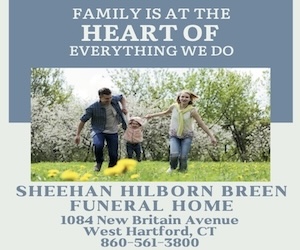
Early postcard: The New England Hebrew Farmers Creamery.
MONTVILLE – When the little wooden synagogue in this eastern Connecticut town was torched by an arsonist in 1975, descendants of its Russian-Jewish founders could not have imagined how significant the site would become.
That first rural synagogue in Connecticut, erected in 1892 by the New England Hebrew Farmers of the Emanuel Society (NEHFES), was the center of a storied Jewish agricultural community, a shtetl in the heart of Yankee territory. Since the 1980s, NEHFES descendants have been active in preserving and commemorating the historic site.
Last month, NEHFES was awarded a $10,000 grant from the Community Investment Act of the State of Connecticut. The organization will use the money to commission a detailed topographical site survey, as part of the nomination process to get the site listed on the National Register of Historic Places.
The site has been included in the Connecticut Trust for Historic Preservation’s Archaeological Preserve since 2007. In December 2010, NEHFES received a $2,500 grant from the Trust to pay for an initial engineering analysis and landscape plan.
The one-room synagogue was first dedicated on May 8, 1892 at the intersection of Routes 161 and 85 in Chesterfield, in the town of Montville. The community was led by Harris (Hirsch) Kaplan, who had arrived with his family in New York in December 1887. A whiskey dealer in Pereyaslov, Ukraine, Kaplan had studied at the Bialystok Yeshiva and was considered an unordained rabbi. Under his religious leadership, a small group of Russian Immigrant Jews, the Society Agudas Achim, organized in Williamsburg in Brooklyn.
When they learned of inexpensive farmland available in Connecticut, the group relocated to Chesterfield in 1890 and purchased farms, using Kaplan’s farmhouse as a makeshift sanctuary for prayer services. Kaplan started a factory where garment piecework was stitched whole and returned to New York clothing manufacturers. The society formalized itself with a mission statement recorded in the town of Montville land records:
“We the subscribers, for the purpose of perpetuating the cause of Judaism in all its essential purity, and cherishing and promoting its great and fundamental principle, in the Rock upon which our undying Faith is founded, the belief in and worship of one God, hereby unite to form a Society for public worship according to the principles and practices of our Faith.”

The invitation to the dedication of the synagogue on May 8, 1892. It reads: The Society of Hebrew Farmers in New England Invite you respectfully to the Dedication of their House of Worship and Education which will take place on Sunday, May 8th, 1892 at one o'clock p.m. at Chesterfield, Conn, near New London. The creamery and the homes of our farmers will welcome visitors. Stages will be waiting at the Boat and R.R. Station, Sunday Morning, from 6 to 10 o'clock at New London.
In January 1892, the group purchased almost two acres of land to house a new synagogue. Two months later, the Baron Maurice de Hirsch Fund in New York provided a $900 loan to build the synagogue and a $3,200 mortgage for the construction of a cooperative creamery for the production of butter, milk, and cream. Revenue from the creamery helped cover maintenance and overhead costs for the synagogue. Capitalized in New York in 1891, the Baron Maurice de Hirsch Fund was instrumental in resettling Russian Jewish immigrants all across America. Chesterfield was its first Connecticut agricultural community, leading to the establishment of others around the state, including Colchester, Ellington, among others.
It was Arthur Reichow, an agent of the de Hirsch Fund, who suggested that the group rename itself “The New England Hebrew Farmers of the Emanuel Society.” Separately, The New England Hebrew Farmers Creamery Association was incorporated under the general statutes of the State of Connecticut in late spring 1892. By 1898, the society had written a set of stringent bylaws to govern its membership. Eventually, the synagogue site grew to include a barn, a house for the shochet, or ritual slaughterer, and a mikvah, constructed in 1914.
These buildings, along with Harris Kaplan’s dance hall, a general store owned by his son John, and Kosofsky’s communal swimming hole, became the vibrant core of a “shtetl in America,” a community of perhaps 50 Jewish families who flourished as small businessmen, boarding-house owners, and farmers until the early 1930s. Although the synagogue continued to operate on the High Holidays well into the 1950s, the building was eventually abandoned. It survived arson in 1972, but was burned to the ground in 1975.
At a ceremony on Sept. 28,1986, in conjunction with the town of Montville’s bicentennial, a monument of Mt. Rushmore granite was dedicated by the descendants of some of the original NEHFES families.
Twenty years later, with the assistance of attorney Karl Fleischmann of Hartford, 19 descendants legally reactivated NEHFES as a (501)(c)3 not-for-profit religious organization in the state of Connecticut, dedicated to the protection and preservation of both the physical site and historic legacy of the New England Hebrew Farmers. Membership contributions were used to research and nominate the Montville site, which was designated Connecticut’s 24th State Archaeological Preserve and listed on the Connecticut State Register of Historic Places in September 2007. “There aren’t really any other sites like this that I know of in the State,” says state archaeologist Nicholas Bellantoni. “It speaks not only to a history in the Montville area, but to a whole movement of immigration of people coming here and setting up farms and communities. It tells an important story.”

The NEHFES synagogue after the first fire in 1972.
Nancy Savin is president of NEHFES and a descendant of founder Harris Kaplan, her maternal great-great-grandfather. Her paternal grandmother’s father, Henoch Ritch, a grain merchant from the Vitebsk district in Belarus, was a cantor in the community who taught boys their bar mitzvah portions. Another ancestor, Jacob Savin, served as president of the synagogue in 1910.
“My parents, Micki and Isadore Savin, were totally caught up in the romance of Chesterfield’s Russian Jewish community,” Savin says. “In her wonderful memoir, ‘I Remember Chesterfield,’ my mother skillfully captured this picturesque and bygone chapter of American Jewish history. Among my most beloved memories are the times I spent in Chesterfield during the 1940s and ’50s, at my grandmother Savin’s farm, attending the synagogue on holidays, swimming in Kosofsky’s swimming hole, and visiting my great-grandfather’s general store.”
Many descendants of NEHFES families reflect the best of the American immigrant story, Savin says. “They are now professors, writers, businesspeople; they work for ABC News in New York, serve on the Board of Trustees of Cornell and Barnard, teach at NYU and Johns Hopkins,” she says. “They are the heirs of their hard-working immigrant ancestors, who benefited from the American opportunity for advancement.” Savin was producer and host of arts programming at Connecticut Public Television between the 1970s and 2002.
Second-generation Savin descendants included A.I. Savin who started his own construction company and helped build the Merritt Parkway and several Connecticut highways, and built the original Charter Oak and Baldwin bridges across the Connecticut River and the Gold Star Memorial Bridge that spans the Thames River between New London and Groton. Moses Savin served as three-term mayor of New London and state senator.
Nancy Savin spearheaded the effort to erect the monument on the synagogue site in 1986. She went on to lobby the Connecticut Historical Commission to conduct a statewide survey of the state’s historic synagogues, which was carried out in 1991. As a result, 15 synagogues were listed on the National Register of Historic Places.
Development of the historic site has been a joint effort between NEHFES and local and state officials, Savin says, including Jack Shanahan, former executive Director of the Connecticut Historic Commission; Connecticut Commission of Culture and Tourism (CCT) grants and survey director Mary M. Donohue; CCT staff archeologist Daniel T. Forest; Robert S. Cless of the Connecticut Department of Transportation’s Environmental Planning Department, Connecticut State Archaeologist Nicholas F. Bellantoni, and Montville town historian Jon B. Chase.
“Preserving and protecting this precious legacy is not only important to our current NEHFES membership, but to those generations of children yet to come who will want to know about their ancestors and how they got their start in America at the turn of the 20th century,” Savin says.
To learn more: www.newenglandhebrewfarmers.org








 Southern New England Jewish Ledger
Southern New England Jewish Ledger









